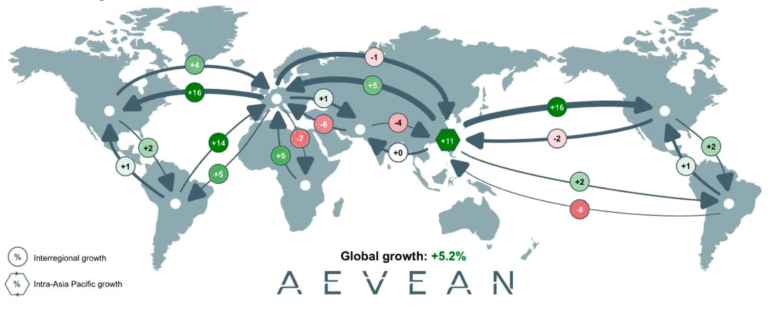- Thriving in freight forwarding requires embracing digital platforms to access new clients, gain commercial visibility, and turn local expertise and agility into scalable advantages, rather than merely reacting to market pressures.
- Technology enables smaller forwarders to reduce acquisition costs, highlight underutilised trade corridors, differentiate through niche services, and reallocate effort from chasing leads to strengthening client relationships.
- Trust, sustainability, and cultural adoption are key: forwarders must integrate technology with human engagement, showcase eco-friendly solutions, and foster consultative selling to remain relevant and competitive in a rapidly digitalising market.
Global airfreight patterns are undergoing a subtle but significant transformation, with the Asia–Europe corridor emerging as the new focal point for growth. According to Aevean’s latest analysis, trade lanes connecting Asia with Europe are expanding faster than any other intercontinental routes, driven largely by the relentless rise of cross-border e-commerce.
“The data show a clear acceleration in Asia–Europe flows,” says Maarten Wormer, Head of Consulting at Aevean. “e-commerce volumes have surged by about 18 percent in the first half of 2025 compared with the same period in 2024. What’s particularly interesting is that this growth is starting to touch Middle Eastern hubs and networks, even though the region isn’t yet among the largest final destinations.”
“Traditional airfreight on lanes such as Asia–US or Asia–Europe is being displaced by e-commerce shipments,” Wormer notes. “Both segments are competing for the same limited capacity. As retailers and logistics players prioritise fast-moving consumer goods, it inevitably squeezes space for other cargo types.”
The figures support this view. Aevean’s analysis shows that since 2019, Chinese low-value e-commerce exports have grown by roughly 45 percent per year, adding more than four million tonnes of additional volume. This surge has redefined how carriers allocate their fleets and how airports position themselves within the network.
From transit stop to strategic player
The Middle East’s role in global airfreight is evolving alongside these trade shifts. Long seen primarily as a transit bridge between Asia, Europe and Africa, the region is now becoming strategically central to the industry’s next growth phase.
“Capacity growth tells the story clearly,” says Wormer. “From April to August this year, available cargo capacity along the Asia–Middle East–Europe corridor grew at double-digit rates, far outpacing the transpacific and transatlantic lanes. The freighter fleet is quite literally being pulled towards this geography.”
That trend reflects both opportunity and constraint. With e-commerce volumes increasingly diverted away from the United States—following the termination of the de-minimis exemption that once made low-value imports more attractive—Europe and Southeast Asia have absorbed most of the redirected traffic. The Gulf states, though smaller in base volume, are benefiting indirectly as carriers reroute and consolidate flows through their hubs.
“The Gulf isn’t yet a major recipient of these parcels,” Wormer acknowledges. “But its airports and airlines are becoming indispensable in moving them. As volumes rise between Asia and Europe, the Middle East’s geographic and operational advantages mean it will naturally gain a greater role in connecting those dots.”
Looking ahead, the numbers point to a deeper structural change. Aevean’s fleet data indicate that most of the world’s freighter and widebody aircraft now on order are destined for Middle Eastern operators. “That will fundamentally reshape the global capacity map over the next decade,” says Wormer. “Depending on how older aircraft are retired, the Middle East could control a much larger share of intercontinental lift. In addition to having more planes, it’s also about more influence over the world’s key trade lanes.”




